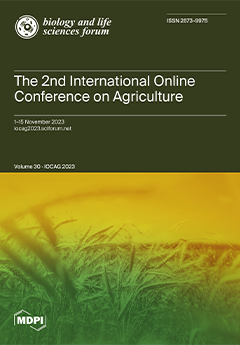Agricultural practices such as tilling, sowing, cropping, It’s duty but arvesting, and land-use patterns in any agrarian economy depend on climate. Therefore, any adverse climatic conditions can seriously affect the production or yield of crops. Increased temperature enhances the susceptibility of crops to pests and various plant diseases. Weeds are also known to multiply rapidly and decrease the nutritive value of soil, negatively affecting crop production. Our present study is designed to address similar problems faced by the farming community in the South-24 Parganas district of West Bengal, India, and suggest several probable technological solutions. Importantly, West Bengal is included in one of the six agro-climatic zones. Major crops from this study site are rice, wheat, maize, jute, green gram, black gram, pigeon pea, lentils, sugarcane, pulses, rapeseed, mustard, sesame, linseed, and vegetables. Significantly, cultivable land area has decreased in comparison to the overall crop area in this region. Reduced interest in agriculture, irrigation problems, increased profit in the non-agricultural economy, and rapid conversion of agricultural land for commercial purposes (construction of plots, hatcheries for fishing practices), along with uncertainties associated with rainfall patterns and frequent cyclones, are matters of grave concern in this study area. Agricultural scientists, researchers, environmentalists, local bodies, and government organizations are suggesting alternatives to benefit farmers. Thus, precision agriculture or crop management is required to recognize site-specific variables within agricultural lands and formulate strategies for improving decision-making regarding crop sowing, appropriate use of herbicides, weedicides, and precision irrigation, along with innovative harvesting technologies. Thus, the present paper provides a vision for the farming community in our study area to overcome their traditional practices and adopt different techniques of precision agriculture to increase flexibility, performance, accuracy, and cost-effectiveness. Soil temperature, humidity, and moisture monitoring sensors could be beneficial. Precision soil management, precision irrigation, crop disease management, weed management, and harvesting technologies are the different modules considered for discussion in this paper. Machine learning algorithms, such as decision tree, K-nearest neighbor (KNN), Gaussian naïve Bayes (GNB), K-means clustering, artificial neural network (ANN), fuzzy logic system (FLS), and support vector machine (SVM), could prove helpful for progressive farmers. The use of AI-powered weeding machines, drones, and UAVs for rapid weed removal and the localized application of herbicides and pesticides could also improve the accuracy and efficiency of agriculture. Utilizing drones fitted with high-resolution cameras could help gather precision field images, proving to be quite helpful in crop monitoring and crop health assessment. Unmanned driverless tractors and harvesting machines using robotics integrated with data from GPS/GIS sensors or radars could also be considered an effective and time-saving option. Thus, machine learning, along with innovative agricultural technologies, could contribute to improving the livelihoods of the farming fraternity.
Full article



